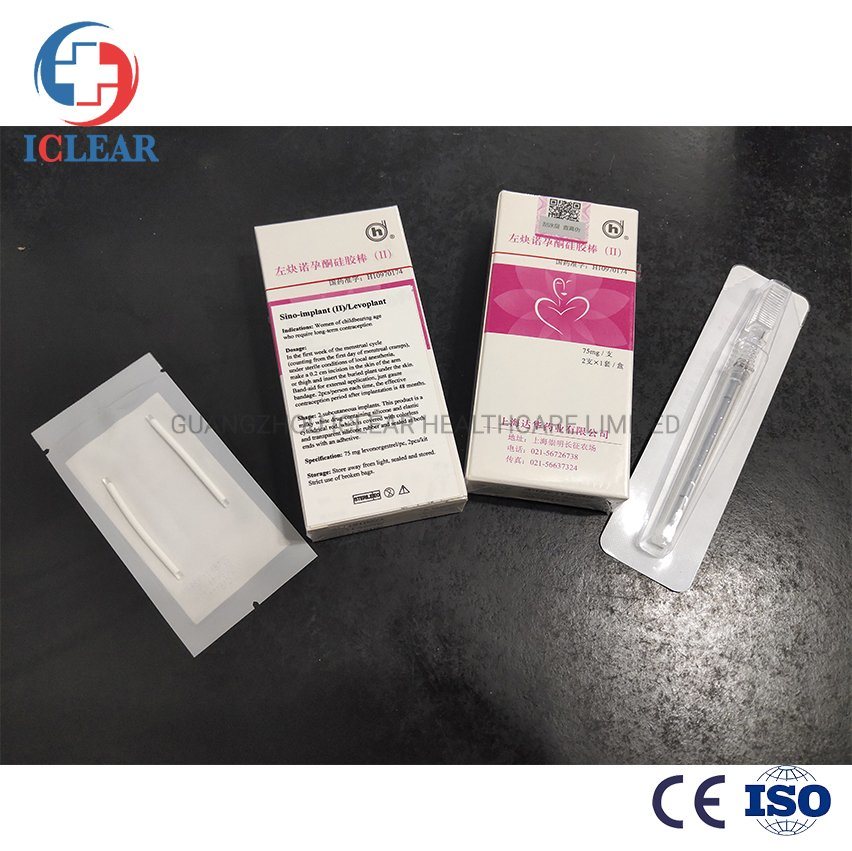

Safe
Highly effective
Reliable
Long-acting
Simple insertion and removal
No daily or monthly action required from the user
Discreet
Reversible
Limited side effects
Affordable
CFDA, ISO 9001 and ISO13485 certified for levonorgestrel silicone elastomer implants, these tests include identification, assay and dissolution of the active ingredient testing as well as product sterility testing.
Sino-implant (II)/Levoplant is a hormonal contraceptive made up of two flexible rods inserted into a woman's upper arm. The implant works by releasing a hormone called levonorgestrel, which is slowly and continuously released over time.
Sino-implant (II)/Levoplant works by preventing a woman's eggs from leaving her ovaries. It also thickens cervical mucus, making it hard for sperm to unite with an egg. When sperm cannot unite with an egg, pregnancy cannot occur.
Sino-implant (II)/Levoplant must be removed after three or four years of use,depending on the national registration. A new set of rods can be inserted at that time if continued protection against pregnancy is desired. After removal of the rods, there is no delay in a woman's return to fertility.
Almost all women of childbearing age can use Sino-implant (II)/Levoplant. This includes women of any age, women with or without children, breastfeeding mothers, women who are HIV positive, women who smoke, and women who have had an abortion.
A small number of women with certain medical conditions should not have Sino-implant (II)/Levoplant inserted. These conditions include an allergy to levonorgestrel or any other ingredients in Sino-implant (II)/Levoplant, unexplained abnormal bleeding, breast cancer or cancer of the lining of the womb, liver tumor or other liver illnesses, and blood clots in the leg, lung, or eye.
Some medications may interfere with Sino-implant (II)/Levoplant's effectiveness to prevent pregnancy. For more information about contraindications for Sino-implant (II)/Levoplant, please speak with your healthcare provider.
Side effects
Like all medicines, Sino-implant (II)/Levoplant can cause side effects, although not everyone experiences them. Changes in menstrual bleeding are the most common side effect of implants, including Sino-implant (II)/Levoplant. These changes can include irregular bleeding, a change in the amount of bleeding or a change in the number of days a woman bleeds. This irregularity typically diminishes with continued use. Some women may stop having menstrual bleeding altogether for as long as they use the implant. An absence of bleeding (amenorrhea) while using this device is not harmful. Fertility and menstruation return when the implant is removed.
Users can experience headaches, dizziness, nervousness, weight gain, nausea, vaginal discharge, lower abdominal pain, cervical inflammation, itching of the external genitals, and breast tenderness. This is not a complete list of side effects. For additional details or to discuss side effects that concern you, talk to your healthcare provider.
You should contact your healthcare provider at any time if you have concerns or questions about Sino-implant (II)/Levoplant. If you notice or experience the following symptoms, you should contact your healthcare provider immediately: pus or bleeding at the insertion site, implants sticking out of the skin, heavy or prolonged vaginal bleeding (twice as much as usual bleeding and lasting longer than eight days), severe pain in the lower abdomen or migraine headaches.
Insertion and removal of the products
Insertion of Sino-implant (II)/Levoplant involves a minor surgical procedure that typically takes only a few minutes and can be done in a doctor's or nurse's office. The implants are inserted into the inner side of either upper arm.
To be immediately effective, the ideal time to insert Sino-implant (II)/Levoplant is within seven days of the onset of your last menstrual bleeding. If it is inserted at another time, you should use another contraceptive method (like condoms) or abstain from sex for the first seven days, after your implant is inserted.
Before inserting Sino-implant (II)/Levoplant, the healthcare provider will ask questions about your medical history, perform a physical examination and make sure you are not pregnant. Then, the inside of the upper arm is cleaned and a local anesthetic is injected to numb the insertion site.
A small incision is made in the numbed skin. The provider inserts the implants just under the skin with a specialized instrument called a trocar. After the procedure, the insertion site is closed with skin tape and bandaged. The site needs to be kept clean and dry for three days, until it heals. There may be some discoloration, bruising or swelling at the implant site for a few days after the insertion but these should not interfere with your normal activities.
Sino-implant (II)/Levoplant is licensed for either three or four years use, depending on the country registration status, but you can have your Sino-implant (II)/Levoplant removed at any time.Return to fertility occurs without delay after removal. If you want to continue using Sino-implant (II)/Levoplant after you have completed its lebeled duration of use, the first set must be removed and a new set inserted.
Removal of Sino-implant (II)/Levoplant involves a minor surgical procedure but may be more difficult than its insertion and leave a small scar. As with insertion, the area of the implant is cleaned and a local anesthetic is injected into the arm to numb the removal site. A small incision is made where the two rods meet. The provider pushes the implant toward the incision and the implants are gently removed using small forceps. The arm is bandaged to allow the incision to heal. Bruising may occur at the site following removal. In cases where removal of the implants has been difficult, there have been reports of pain, numbness, tingling, and scarring of the upper arm.